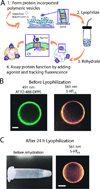G Protein-Coupled Receptors Incorporated into Rehydrated Diblock Copolymer Vesicles Retain Functionality
- PMID: 27529518
- PMCID: PMC5148614
- DOI: 10.1002/smll.201601540
G Protein-Coupled Receptors Incorporated into Rehydrated Diblock Copolymer Vesicles Retain Functionality
Abstract
G protein-coupled receptor (GPCR) is incorporated into polymeric vesicles made up of diblock copolymer bilayers. Successfully incorporated GPCRs exhibit correct biased physiological orientation and respond to various ligands. After extended dehydrated storage via lyophilization and subsequent rehydration, diblock copolymer polymersomes retain their shape and incorporated GPCR retains its function.
Keywords: GPCR; bilayer vesicles; block copolymers; lyophilization; polymersomes.
© 2016 WILEY-VCH Verlag GmbH & Co. KGaA, Weinheim.
Figures



Similar articles
-
Durable vesicles for reconstitution of membrane proteins in biotechnology.Biochem Soc Trans. 2017 Feb 8;45(1):15-26. doi: 10.1042/BST20160019. Biochem Soc Trans. 2017. PMID: 28202656 Free PMC article. Review.
-
Physicochemical properties of L-alpha dipalmitoyl phosphatidylcholine large unilamellar vesicles: Effect of hydrophobic block (PLA/PCL) of amphipathic diblock copolymers.Chem Phys Lipids. 2020 Aug;230:104927. doi: 10.1016/j.chemphyslip.2020.104927. Epub 2020 May 23. Chem Phys Lipids. 2020. PMID: 32454007
-
The Functional Activity of the Human Serotonin 5-HT1A Receptor Is Controlled by Lipid Bilayer Composition.Biophys J. 2016 Jun 7;110(11):2486-2495. doi: 10.1016/j.bpj.2016.04.042. Biophys J. 2016. PMID: 27276266 Free PMC article.
-
Human serotonin receptor 5-HT(1A) preferentially segregates to the liquid disordered phase in synthetic lipid bilayers.J Am Chem Soc. 2014 Oct 1;136(39):13530-3. doi: 10.1021/ja507221m. Epub 2014 Sep 19. J Am Chem Soc. 2014. PMID: 25211019 Free PMC article.
-
Solubilization of G protein-coupled receptors: a convenient strategy to explore lipid-receptor interaction.Methods Enzymol. 2015;557:117-34. doi: 10.1016/bs.mie.2015.01.001. Epub 2015 Mar 18. Methods Enzymol. 2015. PMID: 25950962 Review.
Cited by
-
Recent advances in permeable polymersomes: fabrication, responsiveness, and applications.Chem Sci. 2023 Jun 21;14(27):7411-7437. doi: 10.1039/d3sc01707a. eCollection 2023 Jul 12. Chem Sci. 2023. PMID: 37449076 Free PMC article. Review.
-
Durable vesicles for reconstitution of membrane proteins in biotechnology.Biochem Soc Trans. 2017 Feb 8;45(1):15-26. doi: 10.1042/BST20160019. Biochem Soc Trans. 2017. PMID: 28202656 Free PMC article. Review.
-
Photolithographic patterned surface forms size-controlled lipid vesicles.APL Bioeng. 2018 Jan 2;2(1):016104. doi: 10.1063/1.5002604. eCollection 2018 Mar. APL Bioeng. 2018. PMID: 31069289 Free PMC article.
References
MeSH terms
Substances
Grants and funding
LinkOut - more resources
Full Text Sources
Other Literature Sources

